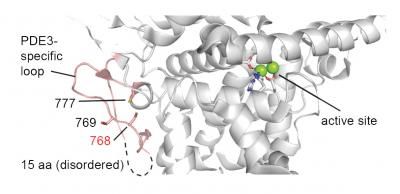Disabling enzyme allows mice to gorge without becoming obese, new study finds
Researchers at the University of California, Berkeley, have identified a new enzyme that plays a far more important role than expected in controlling the breakdown of fat. In a new study in Nature medicine, researchers report that mice that have had this enzyme disabled remained lean despite eating a high-fat diet and losing a hormone that suppresses appetite.
"We have discovered a new enzyme within fat cells that is a key regulator of fat metabolism and body weight, making it a promising target in the search for a treatment for human obesity," said Hei Sook Sul, UC Berkeley professor of nutritional sciences and toxicology and principal investigator of the research.
Sul's research team includes the three co-lead authors of the paper, all from UC Berkeley's Department of Nutritional Sciences and Toxicology: Kathy Jaworski, former post-doctoral researcher; Maryam Ahmadian, graduate student; and Robin Duncan, post-doctoral fellow.
The enzyme in the spotlight, adipose-specific phospholipase A2 (AdPLA), is found in abundance only in fat tissue. AdPLA sets off a chain of events that increases levels of a signaling molecule called prostaglandin E2 (PGE2), which suppresses the breakdown of fat. Mice that have no AdPLA have lower PGE2 levels and a higher rate of fat metabolism.
"When levels of PGE2 are decreased because of the lack of AdPLA, fat breakdown proceeds unchecked, resulting in leanness even in animals that eat all day long," said co-lead author Duncan.
In the study, mice that had the gene for AdPLA expression knocked out were compared with a control group of normal mice. As soon as the mice were weaned at about 3 weeks of age, researchers began offering the two groups of mice an all-you-can-eat buffet of tasty, high-fat foods.
Notably, the enzyme did not appear to affect appetite since the two groups ate equivalent amounts. However, as the mice aged, the disparity in weight gain became clear. By 64 weeks of age - considered the twilight years in a lab mouse's lifespan - the mice that lacked the AdPLA enzyme averaged only 39.1 grams, a weight more typical of a low-fat diet, while the control mice weighed in at a hefty 73.7 grams. The researchers noted that the missing AdPLA did not change the number of fat cells, but simply kept the cells from accumulating excess fat.
The researchers also studied whether loss of AdPLA could prevent genetic obesity in mice. They compared mice that lacked leptin, the hormone that signals when the body is full, with mice that lacked both AdPLA and leptin. Leptin-deficient mice are voracious eaters, typically consuming two to three times more food per day than normal mice, and they rapidly develop obesity.
In this study, leptin-deficient mice ate an average of 5 grams of food per day, while mice that lacked both AdPLA and leptin ate 7.5 grams. Typically, normal mice will eat only 2-3 grams per day. By 17 weeks of age, the leptin-deficient mice were already hitting the scales at 75 grams. In comparison, mice that lacked both AdPLA and leptin weighed just under 35 grams.
The researchers found that levels of AdPLA increase after eating to block fat breakdown, and decrease with fasting to allow fat breakdown to proceed efficiently. They also found that levels of AdPLA are higher in obese mice.
"This means that local signals in fat tissue allow fat cells to directly regulate fuel provision for the body, which changes our fundamental understanding of how the body regulates fat breakdown," said Ahmadian, another study co-lead author. "We found that mice deficient in AdPLA expend more energy than normal mice, and they also burn more fat directly within fat cells."
Before this paper, the assumption had been that the major players in controlling fat metabolism and body weight were endocrine factors, primarily hormones that are secreted by different organs and glands and travel through the bloodstream to fat tissue, the authors said. The new findings show that a large portion of the action is occurring within the actual fat tissue, mainly through the autocrine and paracrine action of PGE2 that acts locally within a cell or small group of cells.
The researchers caution that previous discoveries in fat metabolism and appetite regulation have not always translated well from mice to humans. Although some people have mutations in the gene that codes for AdPLA, it remains to be seen what effect these mutations have in humans, they said. They also noted that inhibiting the expression of AdPLA in mice led to greater insulin resistance and a four-fold increase in fat content in the liver. However, tests of liver function were largely normal.
Nevertheless, AdPLA may become an attractive target in developing a treatment to combat obesity, the researchers said. If excess fat can be burned before it escapes the fat cell, it can never get into the bloodstream to negatively affect other organs, such as the heart.
"We believe that the effects in the liver are due to the extremely high rate of fat breakdown and drastic leanness in these mice, so we are looking to see if reducing rather than completely eliminating AdPLA can provide effective protection against obesity without secondary effects," said Duncan.

























































